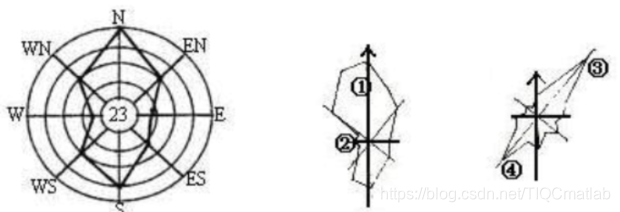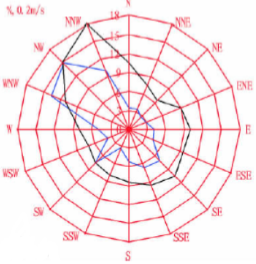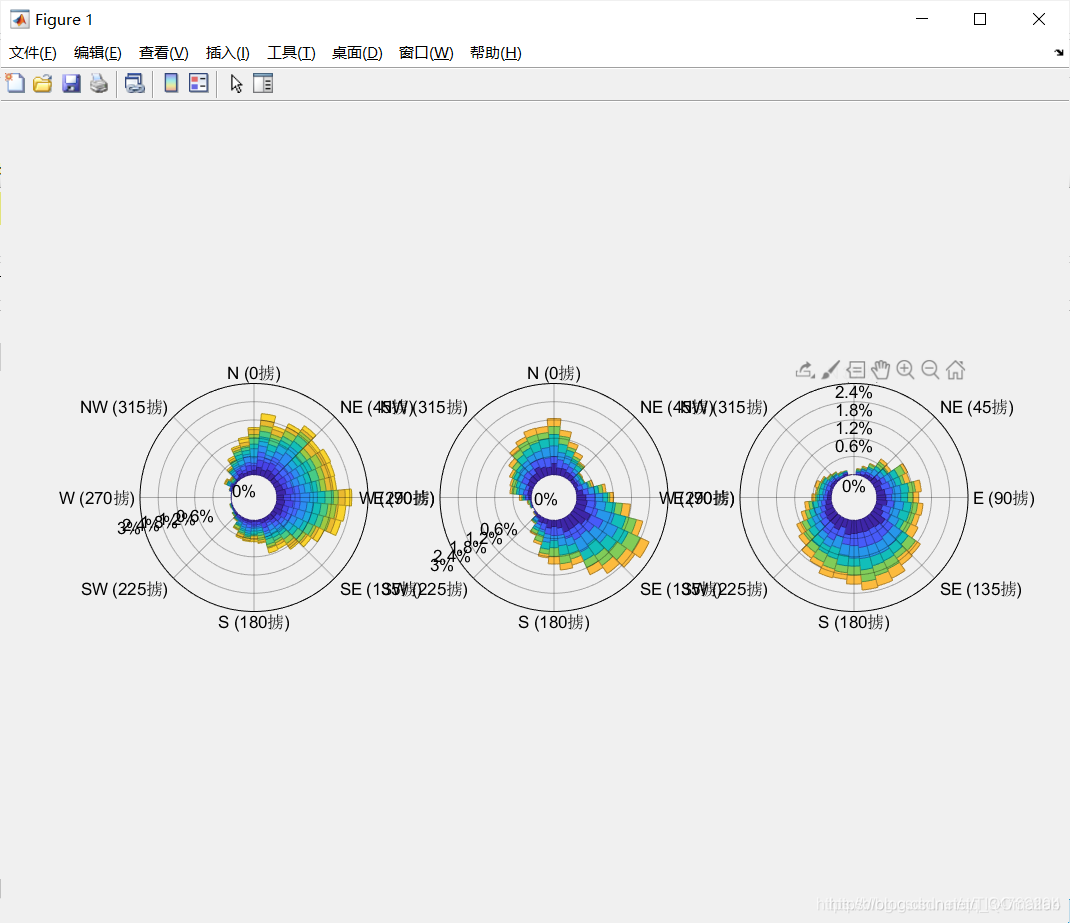一、简介
风玫瑰图分为:风向玫瑰图和风速玫瑰图两种。
1.2
风玫瑰图一般都反映着两个重要信息:风向、风率。
风玫瑰图上所表示的风向即风的来向,是指从外面吹向地区中心的方向
如图:①表示北风,②表示西风,③表示东北风,④表示西南风。

1.3
风向频率:在一定时间内各种风向出现的次数占所有观察次数的百分比。
图中线段最长的,即外面到中心的距离越大,表示风频越大,当地主导风向;
外面到中心的距离越小,表示风频越小,当地最小风频。
如图中①线段最长,为当地的主导风向;②线段最短,为当地的最小风频。
如果当地的主导风向相反,则为季风风向,如图中③④,其主导风向为东北风和西南风。

1.4
风速玫瑰图:
表示各方向的平均风速,其中平均风速用极坐标中的半径表示。
而各个方向风的风速,是以相应的比例长度按风向中心吹,来表达在途中的。
如图。

1.5
同时,建筑物的位置朝向和当地主导风向有密切关系。
把清洁的建筑物布置在主导风向的上风向;把污染建筑布置在主导风向的下风向,最小风频的上方向;污染大气的建筑布局在与季风风向垂直的郊外,以免受污染建筑散发的有害物的影响。

二、源代码
clc; clear; close all;
Options = {'anglenorth',0,... 'The angle in the north is 0 deg (this is the reference from our data, but can be any other)
'angleeast',90,... 'The angle in the east is 90 deg
'labels',{'N (0掳)','NE (45掳)','E (90掳)','SE (135掳)','S (180掳)','SW (225掳)','W (270掳)','NW (315掳)'},... 'If you change the reference angles, do not forget to change the labels.
'freqlabelangle','auto',...
'legendtype',0,...
'min_radius',0.25,...
'titlestring',''};
ax(1) = subplot(1,3,1);
[speed,direction] = WindRandomDistrib(8760,20);
[figure_handle,count,speeds,directions,Table] = WindRose(direction,speed,[Options,{'axes',ax(1)}]);
subplot(1,3,2);
[speed,direction] = WindRandomDistrib(8760,30);
[figure_handle,count,speeds,directions,Table] = WindRose(direction,speed,[Options,{'axes',gca}]);
[speed,direction] = WindRandomDistrib(8760,30);
[figure_handle,count,speeds,directions,Table] = WindRose(direction,speed,[Options,{'axes',subplot(1,3,3)}]);
三、运行结果

四、备注
版本:2014a




 本文介绍了风玫瑰图的基本概念,包括风向玫瑰图和风速玫瑰图,并解释了风向频率和主导风向的概念。此外还提供了如何利用Matlab绘制风玫瑰图的源代码示例。
本文介绍了风玫瑰图的基本概念,包括风向玫瑰图和风速玫瑰图,并解释了风向频率和主导风向的概念。此外还提供了如何利用Matlab绘制风玫瑰图的源代码示例。

















 1万+
1万+

 被折叠的 条评论
为什么被折叠?
被折叠的 条评论
为什么被折叠?










